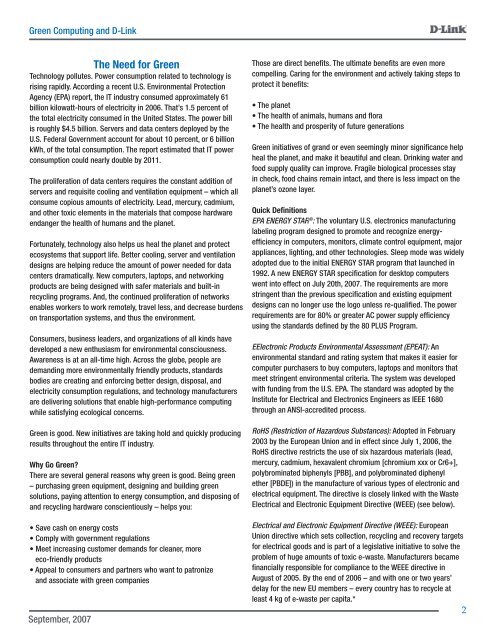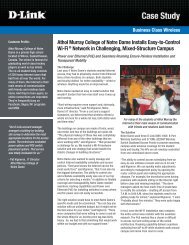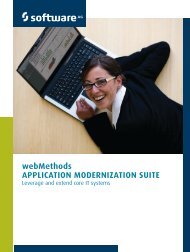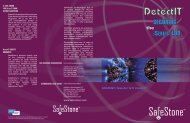Green Computing and D-Link
D-Link Green White Paper - Freelance Technology Marketing Writer
D-Link Green White Paper - Freelance Technology Marketing Writer
- No tags were found...
Create successful ePaper yourself
Turn your PDF publications into a flip-book with our unique Google optimized e-Paper software.
<strong>Green</strong> <strong>Computing</strong> <strong>and</strong> D-<strong>Link</strong>The Need for <strong>Green</strong>Technology pollutes. Power consumption related to technology isrising rapidly. According a recent U.S. Environmental ProtectionAgency (EPA) report, the IT industry consumed approximately 61billion kilowatt-hours of electricity in 2006. That’s 1.5 percent ofthe total electricity consumed in the United States. The power billis roughly $4.5 billion. Servers <strong>and</strong> data centers deployed by theU.S. Federal Government account for about 10 percent, or 6 billionkWh, of the total consumption. The report estimated that IT powerconsumption could nearly double by 2011.The proliferation of data centers requires the constant addition ofservers <strong>and</strong> requisite cooling <strong>and</strong> ventilation equipment – which allconsume copious amounts of electricity. Lead, mercury, cadmium,<strong>and</strong> other toxic elements in the materials that compose hardwareendanger the health of humans <strong>and</strong> the planet.Fortunately, technology also helps us heal the planet <strong>and</strong> protectecosystems that support life. Better cooling, server <strong>and</strong> ventilationdesigns are helping reduce the amount of power needed for datacenters dramatically. New computers, laptops, <strong>and</strong> networkingproducts are being designed with safer materials <strong>and</strong> built-inrecycling programs. And, the continued proliferation of networksenables workers to work remotely, travel less, <strong>and</strong> decrease burdenson transportation systems, <strong>and</strong> thus the environment.Consumers, business leaders, <strong>and</strong> organizations of all kinds havedeveloped a new enthusiasm for environmental consciousness.Awareness is at an all-time high. Across the globe, people aredem<strong>and</strong>ing more environmentally friendly products, st<strong>and</strong>ardsbodies are creating <strong>and</strong> enforcing better design, disposal, <strong>and</strong>electricity consumption regulations, <strong>and</strong> technology manufacturersare delivering solutions that enable high-performance computingwhile satisfying ecological concerns.<strong>Green</strong> is good. New initiatives are taking hold <strong>and</strong> quickly producingresults throughout the entire IT industry.Why Go <strong>Green</strong>?There are several general reasons why green is good. Being green– purchasing green equipment, designing <strong>and</strong> building greensolutions, paying attention to energy consumption, <strong>and</strong> disposing of<strong>and</strong> recycling hardware conscientiously – helps you:• Save cash on energy costs• Comply with government regulations• Meet increasing customer dem<strong>and</strong>s for cleaner, moreeco-friendly products• Appeal to consumers <strong>and</strong> partners who want to patronize<strong>and</strong> associate with green companiesSeptember, 2007Those are direct benefits. The ultimate benefits are even morecompelling. Caring for the environment <strong>and</strong> actively taking steps toprotect it benefits:• The planet• The health of animals, humans <strong>and</strong> flora• The health <strong>and</strong> prosperity of future generations<strong>Green</strong> initiatives of gr<strong>and</strong> or even seemingly minor significance helpheal the planet, <strong>and</strong> make it beautiful <strong>and</strong> clean. Drinking water <strong>and</strong>food supply quality can improve. Fragile biological processes stayin check, food chains remain intact, <strong>and</strong> there is less impact on theplanet’s ozone layer.Quick DefinitionsEPA ENERGY STAR ® : The voluntary U.S. electronics manufacturinglabeling program designed to promote <strong>and</strong> recognize energy-efficiency in computers, monitors, climate control equipment, majorappliances, lighting, <strong>and</strong> other technologies. Sleep mode was widelyadopted due to the initial ENERGY STAR program that launched in1992. A new ENERGY STAR specification for desktop computerswent into effect on July 20th, 2007. The requirements are morestringent than the previous specification <strong>and</strong> existing equipmentdesigns can no longer use the logo unless re-qualified. The powerrequirements are for 80% or greater AC power supply efficiencyusing the st<strong>and</strong>ards defined by the 80 PLUS Program.EElectronic Products Environmental Assessment (EPEAT): Anenvironmental st<strong>and</strong>ard <strong>and</strong> rating system that makes it easier forcomputer purchasers to buy computers, laptops <strong>and</strong> monitors thatmeet stringent environmental criteria. The system was developedwith funding from the U.S. EPA. The st<strong>and</strong>ard was adopted by theInstitute for Electrical <strong>and</strong> Electronics Engineers as IEEE 1680through an ANSI-accredited process.RoHS (Restriction of Hazardous Substances): Adopted in February2003 by the European Union <strong>and</strong> in effect since July 1, 2006, theRoHS directive restricts the use of six hazardous materials (lead,mercury, cadmium, hexavalent chromium [chromium xxx or Cr6+],polybrominated biphenyls [PBB], <strong>and</strong> polybrominated diphenylether [PBDE]) in the manufacture of various types of electronic <strong>and</strong>electrical equipment. The directive is closely linked with the WasteElectrical <strong>and</strong> Electronic Equipment Directive (WEEE) (see below).Electrical <strong>and</strong> Electronic Equipment Directive (WEEE): EuropeanUnion directive which sets collection, recycling <strong>and</strong> recovery targetsfor electrical goods <strong>and</strong> is part of a legislative initiative to solve theproblem of huge amounts of toxic e-waste. Manufacturers becamefinancially responsible for compliance to the WEEE directive inAugust of 2005. By the end of 2006 – <strong>and</strong> with one or two years’delay for the new EU members – every country has to recycle atleast 4 kg of e-waste per capita.*2






